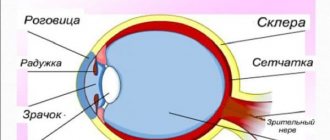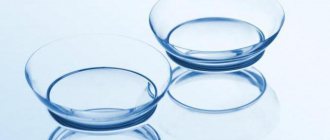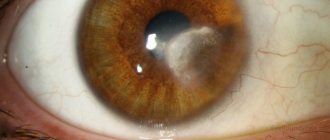What are contact lenses? This is one of the modern methods of vision correction. The lens is installed on the cornea of the eye and, depending on the optical power, increases or decreases the refraction of rays passing through it. For farsightedness, “plus” contact lenses help shift the main focus to the retina.
Types of contact lenses for farsightedness
There are two types of CL used to treat farsightedness: hard and soft. Rigid contact lenses are not used to correct isolated hypermetropia. Such lenses are suitable for correcting farsightedness in combination with lesions of the anterior segment of the eye, in particular the cornea (for example, with keratoconus).
Soft contact lenses (SCLs) are mainly used to correct hypermetropia. Modern materials are used in the production of SCLs. There are silicone hydrogel and hydrogel SCLs.
Hydrogel SCLs contain a large amount of water. This makes them softer than silicone hydrogels. Such SCLs require daily replacement due to their low strength. Silicone hydrogel SCLs contain less moisture, but have greater oxygen permeability. An ophthalmologist determines which lenses a patient should choose.
How do lenses affect the development of farsightedness?
Statements by ophthalmologists, as well as numerous reviews from patients suffering from hypermetropia, indicate that as a result of wearing lenses, this disease does not progress, but they do not have a therapeutic effect.
The key task of lenses is to reduce the load on the visual organs and stabilize their functioning, i.e., they help correct hypermetropia only for a certain period.
Wearing the products is aimed at helping the eyes get rid of excessive tension and temporarily localize the discomfort that has arisen. Let me note once again that lenses help in the course of this unpleasant eye disease, but it is impossible to completely get rid of it without taking more serious measures!
Wearing mode and frequency of lens replacement
Based on the time of use, all soft contact lenses for farsightedness are divided into:
- one-day;
- scheduled replacement (change once a week, once a month);
- traditional (requires replacement every 3, 6 or 12 months).
Ophthalmologists around the world prefer daily CL. Such SCLs are the safest and do not require maintenance. Complications in the form of keratitis and conjunctivitis practically do not occur. The disadvantage of one-day SCLs for farsightedness is their high cost.
Depending on the wearing mode, CLs are distinguished:
- daily wear (no more than 24 hours);
- prolonged wearing (worn without removing for 1 week);
- long-term wearing (can not be removed for 1 month).
It should be remembered that the longer the CL is on the eye, the higher the risk of corneal damage due to lack of oxygen, trauma, and infection.
Types of lenses and their use for hypermetropia
To correct the vision of patients with hyperopia, contact lenses are used, which have virtually no effect on the quality of life. The CL should be prescribed by an ophthalmologist, taking into account the radius of curvature, diameter and optical power.
The main advantage of optics for farsightedness is psychological comfort. Patients want to hide their vision problems from others. CL will help with this, since they are not noticeable when worn.
Multifocal
Manufacturers offer two types of optical devices—intraocular and contact.
The first are implants installed in place of the lens that has lost its strength. The second ones are artificial. Multifocal lenses for hyperopia help to read and write. They have a number of positive aspects that glasses do not have.
Pros:
- convenient to play sports, ski;
- do not cause discomfort;
- no distortion;
- Some models can be worn for up to 1 week without taking them off before bed.
Multifocal lenses have several zones where the optical power changes. This creates clarity of vision.
Bifocal
They contribute to picture clarity at any distance of the object, because a pair of optical zones with different refractive powers work. They have two focuses - for distance and near. The positive one is located at the bottom, the negative one is at the top.
Bifocal lenses allow you to read, work on a computer and play sports. They replace two pairs of glasses with one.
Circular
This type is universal for hypermetropia. The center of far refraction alternates with the near one. The central nervous system independently selects the necessary projection.
Aspherical
With their help, farsightedness is corrected to a moderate degree. The central part is responsible for close distances, and the periphery for long distances.
Aspherics are convenient to use because their shape is close to the natural state of the eye. Focusing of vision occurs faster, even if the user looked at a nearby object for a long time and moved his gaze to the one that is further away.
"Monovision"
This correction method is performed using spherical lenses of different diopters. One allows you to see objects up close, the other - at a distance.
Spherical lenses are not convenient for hypermetropia, since a person has to look at an object with one eye, depending on the distance at which it is located.
Contraindications to wearing SCLs for farsightedness
Contraindications to wearing contact lenses for farsightedness are divided into temporary and permanent. Temporary contraindications include any infectious lesions of the anterior part of the eye - conjunctivitis, keratitis, acute blepharitis, dacryocystitis. After recovery, the doctor will determine whether it is possible to wear SCL.
Permanent contraindications include:
- ptosis of the upper eyelid;
- severe dry eye syndrome;
- severe strabismus;
- corneal scars;
- glaucoma with a significant increase in intraocular pressure.
Contraindications to contact correction
There are diseases for which you should absolutely not wear lenses:
- strabismus, in which the angle of curvature is greater than 15°;
- decreased sensitivity of the cornea;
- dacryocystitis;
- xerophthalmia;
- the presence of compound changes in the tear fluid;
- infection in the eye - conjunctivitis;
- lacrimation disorders;
- blepharitis
- keratitis caused by various reasons;
- intraocular pressure (glaucoma);
- tuberculosis;
- AIDS;
- infectious diseases;
- colds: acute respiratory viral infections, acute respiratory infections, influenza, etc.;
- ptosis;
- subluxation of the lens.
In addition, if you suddenly experience the following symptoms while wearing lenses for vision correction, you need to immediately remove them and consult a doctor:
- dry, itchy, or painful eyes
- redness of the eyeball;
- disturbance in the lacrimation duct;
- swelling, redness of the eyelids;
- if an allergy occurs.
Sometimes contact lenses can cause an allergic reaction in patients who are hypersensitive. Allergies are usually caused not by the lenses themselves, but by solutions containing chemicals intended for cleaning and storing lenses.
Very rarely there are cases when an allergy occurs precisely to the material from which contact lenses are made. To reduce the risk of allergies, it is better to use lenses designed to be worn for 1 day.
Pay attention to the following diseases characterized by decreased immunity, for which wearing lenses is also not recommended:
- hay fever;
- ARVI;
- inflammation of the sinuses;
- flu;
- acute sinusitis;
- Chronical bronchitis.
IMPORTANT! If you are taking any medications, you should carefully study the instructions for taking these medications for contraindications to the use of contact lenses. Taking certain medications may limit the wearing of contact lenses partially or completely.
What is better to use for farsightedness - lenses or glasses?
Contact lenses for farsightedness, unlike glasses, do not limit the patient’s field of vision; vision correction is carried out both in the central zone and in the periphery.
SCLs are not visible to others; it is almost impossible to notice CLs on the cornea without looking closely. This is important, for example, for children with farsightedness. Schoolchildren are sometimes embarrassed to wear glasses, but CLs help correct vision and are not visible to others. In old age, when vision decreases, it is also psychologically difficult for a person to start using glasses. The need to wear CLs is perceived better by such patients.
Eye with contact lens
With SCLs, you can engage in any type of sports activity, except those where there is a risk of water getting on the lenses. They will not fall out of the eye and will not be damaged. Storage of SCLs is more convenient compared to glasses. The container for CL is small and difficult to damage. The CL material does not fog up when the room temperature changes. Unlike glasses, they are comfortable to wear at any time of the year and in any weather conditions.
The disadvantages of SCLs include the need for daily care (except for one-day CLs) and a greater likelihood of developing infectious and degenerative complications compared to glasses.
PRESBYOPIA AND CONTACT LENSES: OPINIONS OF FOREIGN EXPERTS
04.06.2017
Based on materials from the Review of Optometry magazine Contact lenses are a safe and effective method of optical vision correction. They allow the doctor to select an individual key for almost any patient in accordance with his visual needs and lifestyle. But many contact lens users, accustomed to this means of correction, face a problem at presbyopic age: near vision deteriorates... Will it really be necessary to change comfortable contact lenses to reading glasses? On the other hand, many people who have never needed contact lenses or glasses suddenly find it increasingly difficult to distinguish letters on a computer or mobile phone keyboard. How to properly manage such patients? It is important to understand: regardless of his personal experience, a presbyopic patient comes to the doctor during a difficult, transitional period of life. And the further chances of successfully using this correction method will largely depend on the first visit and the first selection of multifocal lenses. The choice of contact lenses for presbyopes is now quite large, the market is growing every year. The doctor must be well versed in the assortment in order to offer the patient exactly the lens that best suits him. The patient’s lifestyle and visual preferences play an important role. But there are many other questions... Which method to choose - monovision or multifocal lenses? Which design is alternating or simultaneous? How to correct presbyopia combined with astigmatism? To answer these questions at least briefly, here is a review of the discussion that took place in the latest issue of Review of Optometry last year. Dr. Joseph Shovlin, OD, medical editor of the Review of Cornea and Contact Lenses (RCCL), notes that presbyopes are eager to get rid of reading glasses and are therefore willing to try contact correction. By now, in developed Western countries, most presbyopes already use contact lenses. Many patients are former emmetropes; they are accustomed to the fact that their vision is fine. However, as presbyopia develops, even emmetropes find that age inevitably affects their vision. Usually such people are very discouraged by this fact. Dr. Shovlin often recommends aspherical multifocal soft contact lenses, either hydrogel or silicone hydrogel, for these patients. In most of these cases, Dr. Shovlin chooses multifocal soft contact lenses from Bausch & Lomb or CIBA VISION, starting with a low supplemental power for near so as not to affect distance vision too much. When higher addition values are needed, he gives myopics undercorrection in the slave eye, gradually transitioning them to lenses with higher additional power. This method works well for a wide range of common addition values. In order for the patient to be satisfied and for wearing multifocal lenses to be comfortable, it is necessary to find some balance between distance and near vision. Sometimes, if patients have particular difficulty seeing near (usually people who spend a lot of time reading), Dr. Joseph Shovlin tries CooperVision's Proclear N soft contact lenses. It is quite common for him to prescribe lenses with different additions or even different types of lenses to the left and right eyes for one patient. Dr. John Rinehart, OD, believes that if a presbyopian specifically requires a rigid gas permeable contact lens, a rigid gas permeable contact lens with an aspherical design will often be the lens of first choice. Experience shows that it is aspherical lenses that provide better vision both at long distances and at medium distances (including when working in the office). If high add is required, these rigid gas permeable contact lenses will not provide the best near visual acuity at normal reading distances, but for many patients they are ideal. Dr. John Rinehart has been practicing contact lenses for 36 years and has tried many different multifocal lenses with varying degrees of success. According to him, the biggest frustration for a contact specialist is when, due to the fault of the manufacturer, the parameters of rigid gas permeable contact lenses are not known accurately enough. In this case, when it comes time to change the optical power, the doctor cannot always foresee how the new selection will affect the fit of the lenses. Another concern is that when wearing many aspherical rigid gas permeable contact lenses, there is a noticeable gap between the center of the lens and the cornea of the eye. This can lead to changes in the shape of the cornea and thus affect visual acuity. Due to dissatisfaction with existing lenses of this type, Dr. Rinehart began to design and manufacture aspherical rigid gas permeable contact lenses himself. The most important thing is to choose the apical radius well: this determines the optimal curvature of the lens in the center and, accordingly, a good fit on the eye (not too flat and not too steep). When making and fitting such rigid gas permeable contact lenses, it is important to first determine how much addition force the patient requires and what eccentricity and apical radius are needed to achieve this additional force. Drs. Mile Brujic, OD, and Jason Miller, OD, also with RCCL, often prescribe contact lenses for presbyopes. Sharing their experience, they emphasize that in this case an individual approach to each person is especially necessary. To successfully select multifocal lenses, it is extremely important to know everything about the patient’s lifestyle - about his work, hobbies, sports and other activities related to vision. Drs. Brujic and Miller distinguish two broad groups of presbyopes based on the amount of time they wear contact lenses: 1. Presbyopes who do not wear contact lenses all the time Presbyopes who do not wear multifocal lenses all day often only use them occasionally for a strictly defined purpose. This could be a sport, a game, a walk, a business meeting or a party - in short, any type of activity in which the use of glasses is undesirable. For such cases, daily multifocal soft contact lenses are best because the patient wears a new pair of lenses each time and eliminates the need to care for them. These patients often prefer monovision: this method gives good results in the early stages of presbyopia, and the loss of stereoacuity with occasional wear is not so important. Now in the West, the modern modification of monovision is more popular, when a monofocal soft contact lens is selected for the dominant eye, and a multifocal one for the slave eye. Sometimes such patients should be given a slight undercorrection in the non-dominant eye, which helps preserve distance vision while improving near vision. But still, taking into account the shortcomings of the monovision method, the best option for this category of patients would be Focus Dailies Progressives lenses manufactured by CIBA VISION - the only one-day multifocal soft contact lenses to date. 2. Presbyopes who wear contact lenses throughout the workday Of course, the most important thing for these patients is quality near and intermediate vision without the need for glasses. Often they have had success wearing contact lenses before developing presbyopia and would not like to switch to glasses (bifocals or progressives). In this case, an individual approach is especially important, because in case of failure, the patient will join the ranks of refuseniks. Drs Brujic and Drs Miller recommend several well-known brands of multifocal soft contact lenses based on their experience. CooperVision's Proclear multifocal lenses are designed to offer a wide range of options and customization options. The design of these soft contact lenses is based on the so-called Balanced Progressive Technology™. The central zone of one lens, intended for the dominant eye, is adjusted for long distance; it is surrounded by an annular progressive zone with positive optical power. The central zone of the other lens is configured for near distance and is surrounded by an annular progressive zone with minus optical power. Drs Brujic and Miller note that the properties of Proclear make these lenses particularly suitable for presbyopes who have dry eye problems. Another excellent choice is the latest Air Optix Multifocal silicone hydrogel soft contact lenses from CIBA VISION. These are breathable lenses with an aspherical design and a central zone designed for near vision. The extra powers are available in low, medium and high to suit a wide range of patients depending on the degree of presbyopia. The Acuvue Oasys line of lenses from Johnson & Johnson is widely used in monovision technology and for the correction of astigmatism. With the introduction of Acuvue Oasys for Presbyopia multifocal soft contact lenses, presbyopia correction has never been easier. These lenses add the familiar comfort of Acuvue Oasys to two optical zones for near and far. Drs Brujic and Drs Miller also have successful experience correcting presbyopia with PureVision multifocal lenses from Bausch & Lomb. These lenses have an aspherical design with the near zone located in the center. There are two levels of additional optical power to choose from - low and high, which relatively simplifies the task of individual selection. Like other silicone hydrogel multifocal soft contact lenses, these lenses can be used in extended wear modes. And finally, a general recommendation from foreign colleagues: when communicating with presbyopic patients, do not miss the opportunity to offer them multifocal contact lenses. Many people are unaware that optometry offers multifocal soft contact lenses and rigid gas permeable contact lenses as ideal solutions for their vision problems. Most often, beginning presbyopes “give up” and buy reading glasses, or worse, they are simply left without correction and squint intensely while sitting in front of a book or newspaper. In order not to scare the patient away, it is important to choose the right words and not focus on possible difficulties, such as getting used to a new method of optical correction. It must be explained that multifocal contact lenses are not some kind of forced measure, but, on the contrary, an opportunity to achieve an ideal balance between near and far vision. Modern medicine cannot yet fight old age, but it is still quite capable of providing presbyopes with clear near vision without resorting to glasses.
Source: Glaz magazine, No. 3-2011
How are MCLs selected?
An ophthalmologist will tell you how to choose the right contact lenses for farsightedness. Only he has the right to determine what lenses the patient needs. At the first stage, a vision test with trial correction and autorefractometry is carried out. The doctor checks for the presence of concomitant diseases by checking the value of intraocular pressure and performing a fundus examination on a wide pupil.
Read in a separate article: Is it possible to wear contact lenses with astigmatism: selection rules
CLs are selected taking into account the most complete correction tolerated by the patient. A special device is used to determine the basic parameters of the patient’s eye, necessary for the correct selection of CL. These include the curvature and diameter of the cornea.
After the studies, the ophthalmologist selects a trial CL for the patient and installs it on the eye. Visual acuity in the lens is checked. The patient removes the trial CL after a few hours. If the wearing was comfortable, dizziness or distortion of objects did not appear, the doctor writes a prescription for CL with the necessary parameters and the wearing mode desired for the patient and the timing of replacement.
Professor - amateur astronomy
A college professor came to the reception with a rather specific request. He recently retired and decided to take up amateur astronomy. “I would like to be able to clearly see the stars in the sky through binoculars and at the same time check the star chart in my hands. But my glasses don’t go well with binoculars,” he said.
The prescription for glasses and their visual acuity are as follows: OD: Sph –1.75; Cyl –0.75; ax 175; Add +2.50. Vis = 1.0. OS: Sph –1.25; Cyl –1.50; ax 5; Add +2.50. Vis =1.0.
Keratometry data are as follows: OD: 43.50 diopters along the horizontal meridian; 44.25 diopters along the 89° meridian. OS: 43.00 diopters along the horizontal meridian; 44.50 diopters along the 95° meridian.
We take into account astigmatism. When corneal and refractive astigmatism coincide, as in this case, there is a wide range of lenses to choose from. Single vision lenses allow the professor to use binoculars, but they will not allow him to view a star chart. Reading glasses have to be put on and taken off, which is not very convenient for him. The best solution, of course, would be multifocal contact lenses.
Simultaneous or alternating design? Many multifocal lenses have a design where the distance and near zones are located in front of the pupil (simultaneous or simultaneous vision). The need to contemplate the starry sky precluded their use. Therefore, I recommended rigid gas permeable (GPG) corneal contact lenses with an alternating design to the professor. With it, the patient looks straight and into the distance through the upper part of the lens, which provides correction for distance vision, and when moving his gaze lower (for near), he uses the part of the lens that provides good vision for reading.
Setting the height of the segment position. When the lower eyelid touches the lower border of the limbus area (Fig. 1), the starting point for segment placement is usually considered to be a point that is 1 mm below the geometric center of the lens. For example, the geometric center of a lens with a diameter of 10 mm is 5 mm below its top edge. Therefore, we place the segment 1 mm lower – 4 mm above the lower edge. If the border of the lower eyelid is slightly higher than the lower border of the limbus, the eyelid will pull the lens and the segment higher, so it needs to be positioned lower. In the opposite case, when the lower eyelid is below the limbus, it will not pull the lens upward when looking into the lower hemisphere of the visual field, and then the alternating design is not suitable. We were lucky: our patient's lower eyelid touched the lower limbus, so he should have been suitable for corneal GP lenses with an alternating design.
Rice. 1. In this case, the border of the lower eyelid touches the limbus. Photographed by K. Martin.
Estimation of segment position. Ideally, after putting on the lens, the segment border should be located below the lower border of the pupil. In the case of the professor, the upper border of the segment turned out to be 2 mm below the border of the pupil. However, when examining the red reflex using an ophthalmoscope at arm's length, it became clear that the segment covered half the pupil when looking down. For the final assessment of the suitability of the lenses, I asked the professor to hold his head straight, and look at the table for testing near visual acuity with his eyes directed downwards and then say when the text on the table becomes clear. It turned out that this occurs at a comfortable angle of inclination of the gaze. I prescribed the selected ZGP lenses for him, and he still uses them with pleasure.
Intermediate distance vision. Although alternating lens designs can effectively meet a patient's visual needs, as happened in the professor's case, not all optometrists are willing to prescribe them because patients often want to see clearly at arm's length, such as on a computer screen. This problem can be solved by using a trifocal lens with an alternating design or a progressive lens. Another option is to prescribe additional glasses with a lens power of +1.25 diopters, so that the patient wears them when necessary over bifocal contact lenses. If you choose a rimless or semi-rimless frame, you can cut off the lower half of the spectacle lenses, so that the user will view nearby objects through the lower segment of the contact lens, which corrects near vision (Fig. 2).
Rice. 2. Single vision computer glasses over bifocal contact lenses Please note that the bottom of the glasses lenses is cut off
Rules for using and storing lenses
Before placing the lens on your eye, you should thoroughly wash your hands with soap and dry them. The CL is removed from the blister (bottle, container) with clean hands and placed on the index finger. With the other hand, you need to pull the lower eyelid down. Using your index finger, the lens is installed on the cornea of the eye, after which you need to make several blinking movements. A correctly installed CL is not felt on the eye. The same is repeated with the other eye. After putting on the lenses, the container in which they are stored must be washed with warm water and soap and left to dry open.
In order to remove the contact lens, you need to move it down with your index finger, and then remove it from the eye with two fingers. The removed lenses are placed in a container with a new special solution for SCL. Modern solutions are universal - they are used to clean, store and disinfect SCLs. The solution in the container should ideally be changed every day, even if the contact lenses themselves are temporarily not used.
For long-term wear of SCLs, enzyme cleaners in the form of tablets are additionally used. These substances remove protein deposits from the surface of the CL.
We invite you to watch a detailed video about the rules for using and caring for contact lenses:
Correction of farsightedness
When choosing a treatment method, the ophthalmologist first conducts an examination to find out the causes of the disease , type of activity, concomitant diseases, and age.
Modern clinics can offer patients optical vision correction or surgical intervention.
Not everyone wants to wear glasses, so the doctor gives the opportunity to use contact lenses, most often multifocal , since with their help you can see objects near and far equally well. A foreign body in the eye can exist comfortably if properly cared for.
If the patient previously had several types of glasses, then after purchasing contact lenses this problem will disappear. You can stay in them around the clock, go to work, play sports, drive a car, sleep. An ophthalmologist resorts to surgery as a last resort, in severe cases of illness, when other methods are powerless. There are also restrictions on age; operations can be performed on people over 18 years of age.
Using SCL for age-related farsightedness
Age-related farsightedness (presbyopia) is characterized by changes in the lens associated with a decrease in its elasticity. The lens stops refracting rays correctly, and as a result, a person’s ability to clearly see objects located at a close distance deteriorates. Presbyopia is often combined with other refractive errors - farsightedness and myopia.
To correct presbyopia, special multifocal CLs are used - for farsightedness and myopia at the same time. The central part of such a lens is designed for working at close range. The optical power of the central part is equal to the optical power of the glasses for farsightedness in this patient. The peripheral region is designed to maintain high visual acuity when looking into the distance. That is, if the patient has isolated presbyopia, this part of the SCL will be “empty” (without diopters). If presbyopia is combined with farsightedness or nearsightedness, this area will have a corresponding refraction.
Multifocal CLs do not differ in appearance from regular ones. The mode of wearing and timing of replacement depend on the manufacturer.
What is farsightedness? Features of the pathology
This visual defect, otherwise called hypermetropia, is characterized by the fact that a person sees any objects relatively well at a certain distance, but distinguishes them very poorly up close. The eyes simply cannot focus on objects located close enough, which creates certain difficulties . Although in some cases, when farsightedness is high, a person is unable to normally distinguish objects even at a distance. You should not think that a person with such a pathology will see something far away perfectly.
Normal vision and farsighted vision
It is quite difficult for those suffering from this disease to perform a number of ordinary activities - reading, writing, doing some simple minor work. Plus, eyes with such a defect are overstrained and more tired during the day, which in addition causes headaches.
Why is farsightedness dangerous?
The main cause of hypermetropia is a change in the size of the eye . The defect is also observed when the refractive power of the organ of vision is insufficient, when the rays are focused not on the retina, where they should, but behind it. As a result, the visible image becomes blurry and indistinct.
Farsightedness (hypermetropia)
On a note! Farsightedness can be normal, or it can be associated with aging of the body. This is the so-called age-related farsightedness, called presbyopia. In both cases, the defect is easy to correct.
Table. Degrees of hypermetropia.
| Degree | Value, dioptres |
| I | Up to 2 |
| II | Up to 4 |
| III | More than 4 |
We are talking about an eye disease called farsightedness.
Complications
Complications when using SCLs arise when the terms and conditions of wearing, storage conditions, or damage to the surface or edge of the lens are violated.
If an infectious eye disease develops, the contact lenses are removed and disposed of. Such CLs cannot be reused, regardless of the remaining shelf life.
To prevent corneal dystrophy and dry eye syndrome, it is necessary to use special moisturizers in the form of drops or gels. Conventional medications should be instilled 15 minutes before putting on the SCL or after removing it. Special preservative-free forms (BC) can be used with a lens installed on the eye. If there is severe discomfort or dry eyes, it is recommended to switch to daily SCLs, as they have a higher moisture content and greater oxygen permeability. Patients note in their reviews that such lenses are more comfortable for the eyes compared to long-term wear SCLs.
Author of the article: Tatyana, specialist for the website glazalik.ru Share your experience and opinion in the comments.
Can people who are nearsighted wear contacts?
The shape of contact lenses allows them to be used for myopia. To correct vision, minus (negative) spherical lenses are used. Unlike glasses, the lens has direct contact with the eye, which eliminates image distortion.
Contact correction products are available for one-day, two-week, monthly, quarterly and annual wear. The first option is considered the safest, but also the most expensive of those proposed. Most people with myopia use products with a long service life. The longer the service life, the more careful lens care should be.
Contact optics is the most important discovery in the field of ophthalmology. Thanks to lenses, a person with myopia feels more confident, can move freely, and even change eye color. Unlike glasses, myopia correction lenses are used to treat many eye diseases. This correction method slows down the rate of development of myopia.
The lens is placed on the eyeball, its structure is similar to the natural membrane of the eye, this allows the eye muscles to function normally. Today, various types and subtypes of contact optics are produced; they are divided into two groups: hard and soft.
More often, to correct vision for myopia, soft spherical correction products are used, which are comfortable and do not cause irritation, but require careful care every day. They are made of breathable material that prevents oxygen starvation of the cornea, therefore they are safe for the eyes.
Hard corrective products are made from a material with a dense, durable structure, which makes them durable and easy to care for. Such lenses are often made to order and, naturally, their price is much higher. If a person has ophthalmological diseases or the threat of corneal deformation, then this correction method is the most effective for correcting vision.
We recommend that you look at the advice of an ophthalmologist, an expert in contact vision correction. He will tell you about the rules for choosing her.
Types of corrective lenses
It is important to choose the most suitable optics for yourself, which differ greatly in properties and purposes of application:
- Spherical. Prescribed for vision correction in cases of hypermetropia, myopia or strabismus.
- Aspherical. These biconvex lenses are rarely prescribed, for example, in cases where other secondary eye diseases are of concern.
- Toric. They are recommended for use if astigmatism develops against the background of myopia.
- Bifocal. Suitable if you have myopia and hypermetropia in one eye at the same time.
- Perifocal. These contact lenses are often prescribed for myopia. Thanks to good light filtration, the retina receives less stress.
- Multifocal. They differ in certain zones intended for close, distant and lateral vision.
Night lenses are prescribed to restore vision. They are used at night. During sleep, the cornea corrects its shape, due to which light rays normally reach the retina the next day. The disadvantage is that night treatments are disposable; the duration of the therapeutic effect is only a day.
Subspecies according to moisture content:
- High water level. Contain up to 73% free liquid, which moisturizes the eye.
- Average water level. The mucous membrane is supplied with moisture up to 55%, this is a good indicator.
- Low water level. Up to 38% liquid, this is not enough; your eyes will need additional hydration while wearing them; such lenses are rarely prescribed.
Wearing time
The duration of use of corrective optics varies. Lenses are classified according to wear time:
- One-day - used once, therefore inexpensive. If a person primarily wears glasses, then this is an inexpensive replacement, for example for going to the gym or walking in bad weather (snow, rain).
- Two weeks. Classic option. The price and properties are the best, so they are in demand.
- Period. They are often used by people with myopia as the main corrective method of vision.
- Quarterly. Duration of wearing is about 3 months. They are expensive and require careful care every day.
- Annual. Although the service life is 1 year, it is advisable to replace them with new ones after 9 months.
At what age can you wear it?
Experts recommend starting to wear lenses no earlier than 14 years of age. This is primarily due to the need to constantly comply with hygiene standards. In addition, before this age, the eyeball develops, so it is important to choose the correct radius of curvature so as not to affect the normal formation of the cornea.
However, if a child’s myopia developed before this age, then nothing prevents parents from starting to accustom their child to using contact correction devices earlier.
The main thing is that he understands the risks associated with improper care and wearing of lenses and can put them on and take them off independently. Read more about this in this article.










